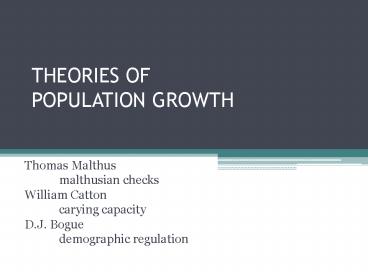THEORIES OF POPULATION GROWTH PowerPoint PPT Presentation
1 / 17
Title: THEORIES OF POPULATION GROWTH
1
THEORIES OF POPULATION GROWTH
- Thomas Malthus
- malthusian checks
- William Catton
- carying capacity
- D.J. Bogue
- demographic regulation
2
THOMAS MALTHUS
3
Who is Thomas Malthus?
- English economist - 1766 to 1834
- Witnessed huge population increases in European
cities (England) due to Industrial Revolution. - Wrote An Essay on the Principle of Population
(1798) in which he argued that populations grow
geometrically but food supply only
arithmetically. - Was one of the first to warn against the dangers
of population growth - Population would soon outstrip food supply.
- Overcrowding led to inadequate housing, lack of
sanitation, widespread crime and other social
ailments
4
Malthusian Checks
- As hunger increased there would be more social
disorder, riots, wars, plagues - famine. - Malthus believed that if left unchecked, the
rapidly growing population would destroy the
quality of life - Malthus believed that the human population had
the ability to double ever generation (approx. 25
yrs) - Argued that moral restraint was only hope no
premarital sex, later marriages.
5
Food supply Population 1 1 2 2 3
4 4 8 5 16 etc.
6
Problems with Malthusian Theory
- Malthus predictions did not materialize
- Birth rates declined soon after death rates did.
Contraception became more widespread. - Industrialization and urbanization meant less
need for family labour. - Population did not double every 25 years
- Cultivation of new territories in the Americas
and Australia also added to the food supply
7
- Better health (public and personal hygiene and
better food) meant lower death rates. - More children survived people lived longer.
- Child labour laws and mandatory schooling laws
meant child had to be supported far longer. - Children became economic liabilities instead of
assets. - Family size shrank.
- Nonetheless Malthusian theory is still relevant
- Many economists believe the time will come when
natural systems will no longer be able to support
the worlds population
8
Many economists believe the time will come when
natural systems will no longer be able to support
the worlds population
- Darfur?
- AIDs?
9
Darfur a Case Study
10
Background
- The dire situation in Darfur dates back to March
2003 - Sudan Liberation Army (SLA) accused President
Omar Hassan El-Bashir of neglecting the region
and oppressing black Africans in favour of Arabs
in the state of Darfur. - The two sides met in armed conflicts since this
time and more than 200,000 people have been
killed while another200,000 have fled to Chad. - Arab militias, with links to the government,
have destroyed food and water resources in West
Darfur, Sudan. - Governments have warned of possible genocide in
the region
11
Famine
- Darfur may well be the first war influenced by
climate change - In recent years, increasing drought cycles and
the Sahara's southward expansion have created
conflicts between nomadic and sedentary groups
over shortages of water and land
12
- Climate change, population growth, rising
consumption patterns and globalization are all
contributing to the phenomenon - In places like Africa the infrastructure and the
government are weak - This allows pressures to multiply and creates
conflicts and schisms - These conflicts often occur along religious or
tribal lines since that is how society is
organized
13
Population
- Like most African nations Sudan is experiencing
high levels of population growth - Natural Increase 2.6
- Population is expected to double by 2050
14
William Catton
- Catton wrote Overshoot The Ecological Basis of
Revolutionary Change which examined current
population trends - Catton coined the term carrying capacity
- People accused him of being a neo-Malthusian
(attempting to revive Malthus theory) - Carrying capacity is defined as the number of
people a given environment can support
indefinitely - Therefore the needs of the population are
balanced against the health of the environment
15
Can the world carry an increasingly affluent
Population?
- Catton believed that European expansion into
under populated areas of the Western and Southern
Hemispheres in the sixteenth and seventeenth
centuries, laid the foundation for todays
population crisis - Once growth and prosperity became common, people
expected the spiral to continue - This led to the drawing down of non-renewable
resources (stealing of resources from future
generations) - Catton argues that once the earths non-renewable
resources are gone, the earths carrying capacity
will drop dramatically
16
D.J. BOGUE
- Writing in the 1960s, D.J. Bogue described what
he called the theory of demographic regulation - Meaning, over an extended period of time society
naturally limits its population. - Population will only grow if the Earth is able to
support it. - The population explosion of the last 150 years
may lead people to believe that this theory does
not work, however supports of demographic
regulation believe that the industrial revolution
has dramatically raised Earths carrying
capacity, and the worlds population has been
adjusting to this increase. - Sweden has completed this process, while for a
country like Mexico this process continues
17
Examples of Demographic Regulation

